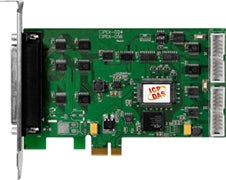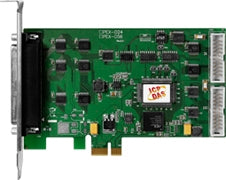

PEX-D56 56-channel Digital IO Board (PCI Express)
- £122.00
- £122.00
- (-0%)
- Unit price
- per
PCI Express Digital I/O card providing 56 TTL digital I/O lines, consisting of three 8-bit bi-direction ports.
Subtotal:
£122.00
Couldn't load pickup availability
Free Shipping
Free standard shipping on orders over £500
Free Returns
30 Day Money Back Guarantee
Description
xThe PEX-D56 provides 56 TTL digital I/O lines, consisting of three 8-bit bi-direction ports. The 8-bit ports are named port A (PA), port B (PB), port C (PC) with all ports being configured as inputs upon power-up or reset.
The PEX-D56 has one D-Sub connector plus 2off 20-pin headers and supports PCI Express x1 bus.
The PEX-D24/D56 has a Card ID switch with which users can recognize the board by the ID via software when using two or more PIO-D24U/56U and PEX-D24/D56 cards in one computer.
These cards support various OS versions, such as Linux, DOS, Windows 98/NT/2000 and 32/64-bit Windows 7/Vista/XP. DLL and Active X control together with various language sample program based on Turbo C++, Borland c++, Microsoft C++, Visual C++, Borland Delphi, Borland C++ Builder, Visual Basic, C#.NET, Visual Basic.NET and LabVIEW are provided in order to help users to quickly and easily develop their own applications.
Features
x- Supports PCI Express x 1 for PEX-D24/D56
- Up to 56/24(PIO-D56/PIO-D24) channels of digital I/O
- Bi-direction programmable I/O ports under software control
- All I/O lines buffered on the board
- 8-bit groups independently selectable for I/O on 24-bit port
- Double side SMD, short card.
- Connects directly to DB-24PR, DB-24PD, DB-24RD, DB-24PRD, DB-16P8R, DB-24POR, DB-24SSR, DB-24C or any OPTO-22 Compatible daughter boards
- 4 interrupt sources: PC0,PC1,PC2,PC3
- One DB37 connector, two 20-pin headers(only for PIO-D56(U) and PEX-D56)
- No base address or IRQ switches to set
- Output status readback
Specifications
x| Model Name | PIO-D24U | PEX-D24 | PIO-D56U | PEX-D56 | ||
| Programmable Digital I/O | ||||||
| Channels | 24 | |||||
| Digital Input | ||||||
| Digital Input Channels | N/A | 16 | ||||
| Compatibility | 5 V/TTL | |||||
| Input Voltage | Logic 0: 0.8 V max. Logic 1: 2.0 V min. | |||||
| Response Speed | 1 MHz | 500 kHz | 1 MHz | 500 kHz | ||
| Digital Output | ||||||
| Digital Output Channels | N/A | 16 | ||||
| Compatibility | 5 V/TTL | |||||
| Output Voltage | Logic 0: 0.4 V max. Logic 1: 2.4 V min. | |||||
| Output Capability | Sink: 64 mA @ 0.8 V Source: 32 mA @ 2.0 V |
| ||||
| ||||||
| Response Speed | 1 MHz | 500 kHz | 1 MHz | 500 kHz | ||
| General | ||||||
| Bus Type | 3.3 V/5 V Universal PCI, 32-bit, 33 MHz | PCI Express x 1 | 3.3 V/5 V Universal PCI, 32-bit, 33 MHz | PCI Express x 1 | ||
| Data Bus | 8-bit | |||||
| Card ID | Yes (4-bit) | |||||
| I/O Connector | Female DB37 x 1 | Female DB37 x 1 20-pin box header x 2 | ||||
| Dimensions (L x W x D) | 134 mm x 86 mm x 22 mm | |||||
| Power Consumption | 420 mA @ +5 V | 580 mA @ +5 V | ||||
| Operating Temperature | 0 ~ 60 °C | |||||
| Storage Temperature | -20 ~ 70 °C | |||||
| Humidity | 5 ~ 85% RH, non-condensing | |||||
Technical
xSOFTWARE
- DOS Lib and TC/BC/MSC sample program (with source codes)
- DLL and OCX SDK for Windows 95/98/NT/2K.
- DLL and OCX SDK for 32-bit and 64-bit Windows XP/2003/Vista/7.
- VB/VC/Delphi/BCB/VB.NET/C#.NET/VC.NET/MATLAB sample programs with source codes.
- LabVIEW toolkit for Windows.
- Driver for Linux and DasyLab.
Applications
xRelated Products
Example product title
- £122.00
- £122.00
- (-0%)
- Unit price
- per
Example product title
- £122.00
- £122.00
- (-0%)
- Unit price
- per
Example product title
- £122.00
- £122.00
- (-0%)
- Unit price
- per
Example product title
- £122.00
- £122.00
- (-0%)
- Unit price
- per
Example product title
- £122.00
- £122.00
- (-0%)
- Unit price
- per
Example product title
- £122.00
- £122.00
- (-0%)
- Unit price
- per
Example product title
- £122.00
- £122.00
- (-0%)
- Unit price
- per
Example product title
- £122.00
- £122.00
- (-0%)
- Unit price
- per
Example product title
- £122.00
- £122.00
- (-0%)
- Unit price
- per
Example product title
- £122.00
- £122.00
- (-0%)
- Unit price
- per
Recently Viewed Products
Example product title
- £122.00
- £122.00
- (-0%)
- Unit price
- per
Example product title
- £122.00
- £122.00
- (-0%)
- Unit price
- per
Example product title
- £122.00
- £122.00
- (-0%)
- Unit price
- per
Example product title
- £122.00
- £122.00
- (-0%)
- Unit price
- per
Example product title
- £122.00
- £122.00
- (-0%)
- Unit price
- per
Example product title
- £122.00
- £122.00
- (-0%)
- Unit price
- per
Example product title
- £122.00
- £122.00
- (-0%)
- Unit price
- per
Example product title
- £122.00
- £122.00
- (-0%)
- Unit price
- per
Example product title
- £122.00
- £122.00
- (-0%)
- Unit price
- per
Example product title
- £122.00
- £122.00
- (-0%)
- Unit price
- per
- Choosing a selection results in a full page refresh.

